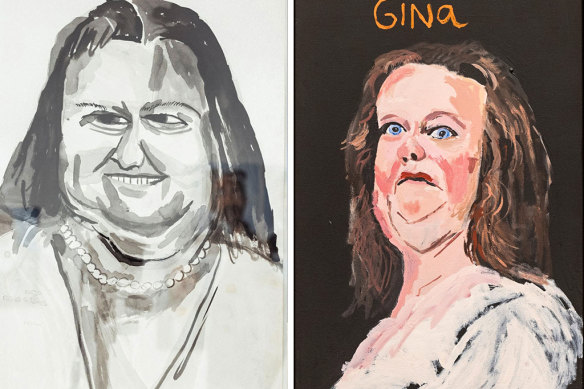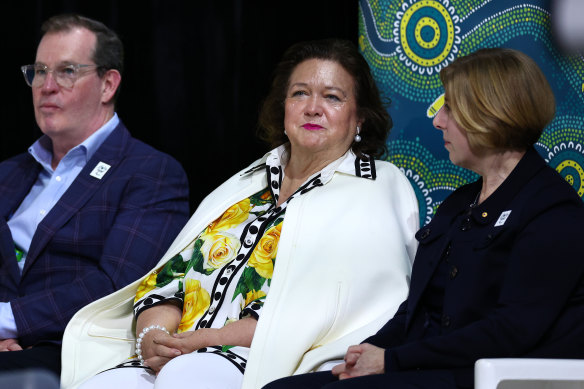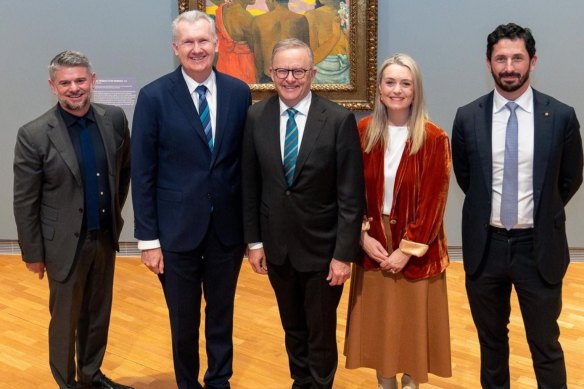- Exclusive
- Culture
- Art & design
- Art
This was published 9 months ago
Rinehart asked National Gallery to ‘permanently dispose’ of portraits
By Linda Morris and Eryk Bagshaw
Billionaire miner Gina Rinehart asked the National Gallery of Australia to “permanently dispose” of two portraits of her by the award-winning Indigenous artist Vincent Namatjira.
Documents released under freedom-of-information laws on Thursday night reveal Australia’s richest person appealed directly to the National Gallery’s chair Ryan Stokes in April to demand the “so-called” portraits be taken down.

Vincent Namatjira’s portraits of Gina Rinehart were the subject of requests for removal.
The emails were the start of a month-long campaign against the portrait by Rinehart, her company Hancock Prospecting and some of Australia’s top athletes to have the paintings removed from the National Gallery.
Namatjira’s exhibition, which closed in July, also included satirical portraits of Queen Elizabeth, AFL star Adam Goodes and former prime minister Julia Gillard. The Indigenous artist and Archibald Prize winner is known for his rawness and sardonic treatment of subjects.
The exhibition titled Vincent Namatjira: Australia in colour had been open for more than a month when Rinehart contacted Stokes about the portraits after a supporter alerted her to their existence.
Rinehart directly requested Stokes to “pl [sic] permanently dispose of the 2 so called portraits of me”.

Gina Rinehart attends the Paralympic team announcement in June.Credit: Getty Images
Stokes, who is also the managing director of Seven, immediately referred the “interesting” message to NGA director Nick Mitzevich.
“Not sure entirely how we respond, but we will need to think about it,” Stokes said.
Within hours Stokes had framed a response to Rinehart thinking it “might be helpful ... if the Director of the National Gallery speaks with someone” she nominated “to discuss the context and possible options”.
Mitzevich advised Stokes that it would be probably “not helpful to enter into a debate on the artistic merits of the paintings”.
The FOI revealed more than 26 emails from Rinehart’s supporters did not sway the gallery into removing the paintings, which said it welcomed public debate and “presented works of art to the Australian public to inspire people to explore, experience and learn about art”.
Those friends included Olympic gold medallist Kyle Chalmers, a female entrepreneur and a patron of the arts, raising questions about the intersection of Rinehart’s use of money and power to influence culture and sport. Rinehart has a fortune estimated at $37.6 billion and sponsors several Olympic sports including rowing and swimming.
The emails from her supporters described Rinehart as “One of Australia’s most prestigious people” and “our most powerful and successful woman” as they called for the portraits be removed for their “disrespectful” and “extremely upsetting” depictions of the miner.
One suggested the “insult” be met with a formal written apology from the NGA expressing regret for the “disrespectful portrayal”. Another described the works as “tawdry commercialism at best, cheap shots, resonating from a platform of ignorance”.

Ryan Stokes (right) with National Gallery of Australia boss Nick Mitzevich, Arts Minister Tony Burke, Prime Minister Anthony Albanese and his partner Jodie Haydon.Credit: AFR
“In my opinion, this artwork should be removed and replaced with a portrait celebrating her and all she has done and continues to do for Australia,” one supporter said.
But the campaign had the opposite effect, propelling the portraits to international attention, creating a surge in gallery visitor numbers and media coverage across Europe and the United States.
Fellow Archibald Prize winner Blak Douglas applauded the NGA’s decision to keep the portrait up and not buckle to pressure.
“It’s evident her narcissism has been challenged by one simple portrait,” he said in May.
“One positive thing about exhibiting as a political artist is that by and large Australians have a great satirical appreciation. We are a nation of humorists and satirists and generally people will have a good chuckle about these things.”
Start the day with a summary of the day’s most important and interesting stories, analysis and insights. Sign up for our Morning Edition newsletter.